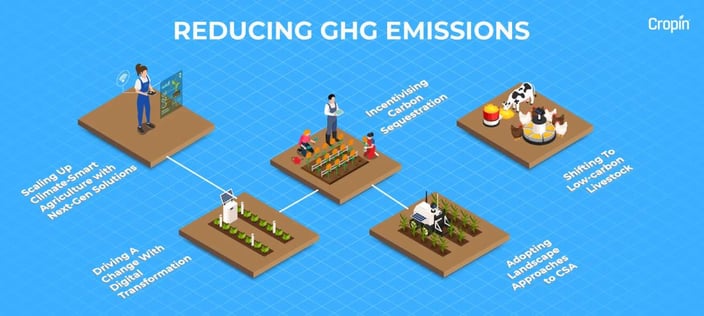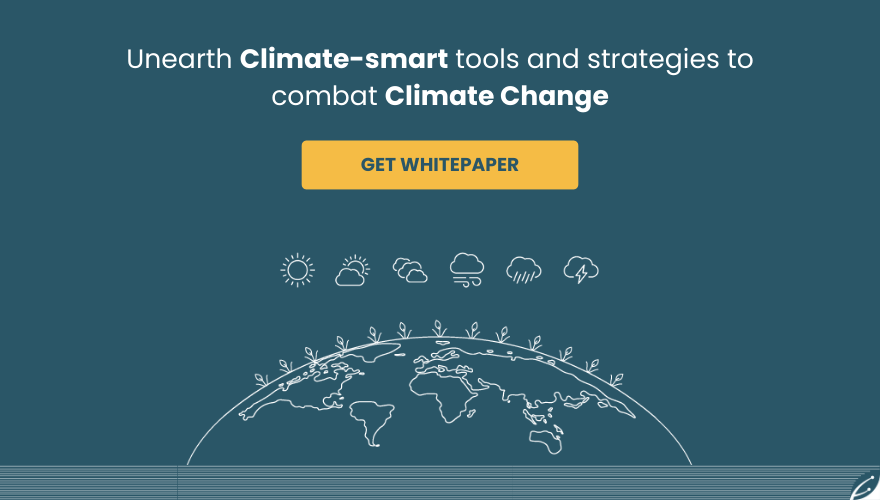The role of the agriculture sector in greenhouse gas (GHG) emissions is known widely, but it is not well understood. The fact that nearly one-quarter of the total anthropogenic GHG emissions occur because of agriculture, forestry, and land-use change (AFOLU), advocates for the same. We need to address this issue actively and inch closer to creating zero-carbon farms, or these emissions increase further as the population of the Earth and the need for food continues to grow.
Agriculture’s Impact on Climate Change
Since 1880, the global annual temperature has escalated at an average of 0.08°C (0.14°F) per decade. In the years since, it has risen to over twice that rate (+0.18°C / +0.32°F), according to the 2020 Annual Climate Report. We need “immediate, rapid, and large-scale reductions” in GHGs to limit the warming to 1.5°C. To achieve this, we will have to stay within the cumulative carbon budget of 570 gigatons of carbon dioxide (GtCO2). It means that we need to reach net-zero carbon emissions globally around 2050 while significantly reducing the emissions of other gases, including methane and nitrous oxide.
- By limiting the impact of climate change to 1.5 °C, we would induce significant changes in agriculture. They include the way we farm and consume our food, along with how we manage to keep our forests and natural carbon sinks the way they are.
- Achieving these changes might seem like a piece of cake, but it is more challenging for agriculture than for other sectors. The pace of emission reduction is too slow across the board for the agriculture industry. Meanwhile, other sectors have identified several technologies that substantially reduce emissions.
- For instance, the energy sector has made it possible to replace coal and gas with wind, solar, and storage. But there is no such emissions-reduction technology in agriculture as of now.
Furthermore, the agriculture sector is significantly less consolidated than other sectors. And reducing emissions needs action by more than two billion people (or one-quarter of the global population) employed in the sector, which is not an easy task. Additionally, besides the climate goals, the sector has other complicated objectives to consider, such as biodiversity, food security, nutritional needs, and the livelihood of farmers and farming communities.

How Can The Sector Reduce GHG Emissions?
1. Scaling Up Climate-Smart Agriculture with Next-Gen Solutions
Climate-smart agriculture (CSA) is a holistic approach to managing diverse landscapes, be it cropland, forests, fisheries, or even livestock, to address the interrelated challenges of food security and climate change. Carbon farming practices effectively aid the removal of atmospheric carbon dioxide at a relatively low cost.
In agriculture, these practices include no-till farming, planting cover crops, using quality seeds, efficient fertilizer application, integrated pest management, and sustainable management of water and land (both crop and grazing land). In addition, restoring degraded lands, preserving existing forests, and biodiversity management also aid carbon farming. However, the primary stakeholders directly involved in the farming process, i.e., the farmers themselves, need adequate access to information and tools to promote soil carbon sequestration and reduce the agricultural emission of greenhouse gases to build zero-carbon farms.
2. Driving A Change With Digital Transformation
Scalable digital interventions can help ensure that farmers have adequate access to relevant information on low- or zero-carbon farming practices. Digital apps are instrumental in harnessing crucial data from the farm, either manually or from IoT devices, agri-machinery, and satellite imagery. They deliver meaningful insights that enable agronomists and other stakeholders to recommend soil carbon sequestration practices.
Consequently, farmers engage in sustainable practices tailored to the needs of their farmland, facilitating them to use suitable inputs in the right place. Further, it guides them with the precise and optimal use of water, fertilizers, and other agri-inputs, thereby preserving resources, limiting greenhouse gas emissions, and helping create zero-carbon farms.
3. Incentivizing Carbon Sequestration
The incentive theory of human motivation suggests that people are motivated to follow a course of action or adopt certain behaviors by their desire for external rewards or incentives.
A fundamental reason for the low adoption of CSA is the absence of definitive economic rewards for producers who adopt these practices. Where training and capacity building help farmers get on the path to zero-carbon agriculture, incentive systems encourage them to make significant progress in that journey.
Several private sector entities are implementing initiatives (such as Carbon Initiative and BioCarbon Fund) to reward farmers who adopt CSA. One such solution is in the form of carbon credits. Indeed, this is a relatively new business model still taking shape worldwide. Nonetheless, digital solutions can ensure accurate measurements for the outcomes of carbon farming practices. These measurements can further help meet the dual goal of improving overall soil health and fulfiling the stringent requirements to engage with carbon markets.
What Are Carbon Credits?
Carbon credits are highly regulated financial instruments that businesses use to compensate for or ‘offset’ their carbon emissions. In other words, it is a permit allowing the entity to emit only a specified volume of greenhouse gases. With one carbon credit, an entity can emit up to one metric ton of carbon dioxide or the equivalent mass of any other GHGs.
In the voluntary, incentive-based carbon markets, agriculturalists (farmers, ranchers, and other agri landowners) can generate carbon credits by reducing their carbon footprint, achieved by adopting management practices that reduce emissions or capture and store emissions (e.g., soil carbon sequestration). They can then sell these credits to entities seeking to reduce or offset their emissions.
4. Adopting Landscape Approaches to CSA
Humans impact terrestrial carbon sinks through land use, land-use change, and forestry (LULUCF) activities. Consequently, this alters the flow of carbon between the atmosphere and the terrestrial biosphere system (aka, the carbon cycle).
Nature-based solutions can aid in limiting future emissions and continuously removing carbon from the atmosphere. One such carbon-sequestering technology that is both cheap and efficient is photosynthesis, where the transfer of carbon from the air to above-ground biomass and soils occurs naturally.
Landscape approaches to CSA, while promoting both climate change adaptation and mitigation, also counter land degradation and enhance agricultural productivity and food security. It includes practices such as agroforestry, afforestation/reforestation, sustainable forest management, improved range-land management, reduced deforestation, and integrated watershed and river basin management, among others.
Incorporating these biosequestration practices into agricultural systems can contribute to bringing a balance between agricultural GHG emissions and carbon removals.
5. Shifting To Low-carbon Livestock
Livestock systems account for three prominent GHG emissions: methane, nitrous oxide, and carbon dioxide. Methane has a short lifetime in the air (approximately 12 years) among the GHGs but is far more effective than carbon dioxide at capturing heat. On the other hand, nitrous oxide has a lifetime of 114 years with significantly more global warming potential.
Animal-source foods, including meat, milk, eggs, cheese, and yogurt, are essential to ensure food and nutrition security among the hungry and malnourished. Nevertheless, manure and gastroenteric releases from livestock contribute nearly 32% of human-induced methane emissions.
Low-carbon livestock aims to reduce the emissions of the three GHGs listed above. It allows countries to continue producing the much-needed animal-source foods and yet do so in a sustainable manner that reduces the overall GHG emission into the atmosphere.
Some of the practical actions that help achieve low-carbon livestock are:
- adopting better management practices, like improved feeding, animal health, genetics, general husbandry, and information technology that boost production efficiency;
- promoting a circular bio-economy to reduce the loss of resources and nutrients by repurposing unused crop residues, food waste, and agro-industrial by-products for animal feed, using manure as soil fertilizer, and generating renewable energy from biogas;
- directly offset agricultural emissions by adopting regenerative agriculture practices of grazing, implementing carbon farming practices, and reducing deforestation, among other nature-based solutions;
- preventing the over-consumption of animal-source foods and opting for alternative proteins with less environmental impact; and,
- enforcing public policy interventions in the above action areas and driving change by engaging stakeholders with appropriate incentives.
Digital Transformation: The Way to Zero-Carbon Farms
Laser land-leveling technology could prove to be a game-changer for low- and middle-income regions to achieve zero-carbon farms. In addition, local advisory networks and research institutes can use technology diffusion and farmer education, too.
Data, analytics, and digital tools are the saviors that improve how we measure and monitor carbon. Not only this, but they also help us provide farmers with the information and insights they need to make the best decisions in their fields. For instance,
- Digital apps harness data gathered from satellites, in-field sensors, and smart farm machines to help farmers identify and address problems way before they take hold.
- It is also crucial to tailor such solutions to each farm’s needs, i.e., producing the right product in the right place, at the right time, and in the right amount. It can help farmers conserve resources while reducing greenhouse gas emissions.
- Innovations like aerial drones allow farmers to precisely apply crop protection tools to a broader area in a fraction of the time. And the best part is that they require less manual labor. Precision Agriculture employs agriculture drones that can cover the same area in only two percent of the previously required time.
But to implement technology to make zero-carbon farms a reality, we will need strong partnerships and a commitment to innovation, along with a common purpose to transform our food system for the better. Hence, we need to build trust through transparency and open dialogue to advance business models across the sector and technologies to help us achieve a carbon-zero future for agriculture.
Cropin collaborates with diverse private and public sector organizations to bring about a far-reaching digital transformation in the global agriculture sector. Cropin’s digital platform couples farm-level information with earth observation and weather data to empower agribusiness with end-to-end decision-making solutions. Our data-backed insights not only enable growers to increase farm productivity sustainably but also facilitate them to move closer to their zero-carbon goals more rapidly.
Accelerate digital transformation and business growth with Cropin Cloud to create a sustainable agri-value chain.











